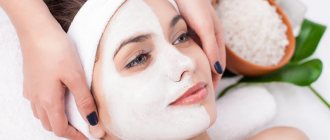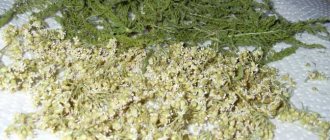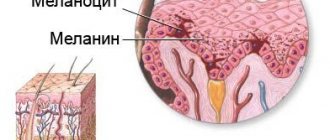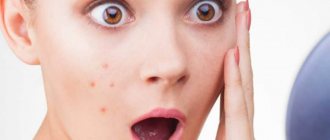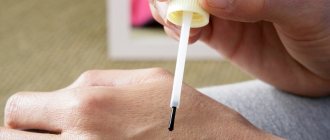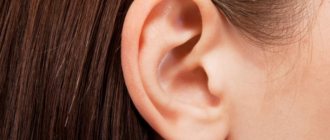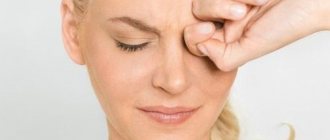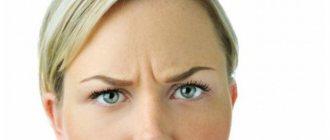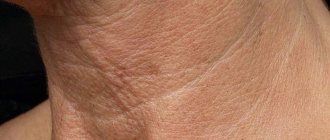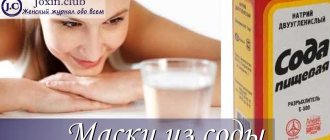Previous: Egg Pimples
Among the many types of rashes on the face and body, blue pimple is considered especially unpleasant.
It belongs to the subcutaneous formations, often becomes inflamed and causes pain.
Getting rid of internal acne is difficult, but still possible.
- All information on the site is for informational purposes only and is NOT a guide to action!
- can give you an ACCURATE DIAGNOSIS !
- We kindly ask you NOT to self-medicate, but to make an appointment with a specialist !
- Health to you and your loved ones!
This must be done correctly due to the fact that such acne often leaves visible scars, cicatrices and traces of pigmentation.
The main thing is not to panic, be patient and prepare for the fact that you may need the help of a doctor.
Causes of deep acne
Deep acne is most often localized on the cheeks, chin, nose and cheekbones. Oily and combination facial skin is most susceptible to this phenomenon; for example, girls with mixed skin may notice the appearance of subcutaneous acne in the T-zone. In this case, the inflammation is located in the deep layers, which explains the long process of their maturation, which can sometimes take more than a month.
Normally, the sebaceous secretion freely leaves the skin glands to the outside. If this process is disrupted for some reason, then deep acne becomes not such a rare occurrence. Subcutaneous inflammation often occurs due to a cold. Insufficient cleansing of the skin and the habit of touching your face with your hands also increase the risk of developing internal acne.
Other factors dermatologists include:
- increased sweating;
- diseases of the digestive system;
- squeezing out blackheads without following hygiene rules;
- weakened immune system;
- vitamin deficiency;
- frequent stress;
- smoking;
- frequent or prolonged exposure to UV rays, for example, through excessive use of a solarium.
Hormonal factor
In cases where the appearance of deep acne on the face is often observed, it makes sense to be examined by an endocrinologist, since the problem may be associated with diseases of the ovaries (polycystic or inflammation), pituitary gland or thyroid gland. Usually, after adequate treatment of these problems, the condition of the skin on the face returns to normal, and internal acne ceases to bother you. It is noticed that
Subcutaneous acne can also be caused by long-term use of hormonal medications. At the same time, depression and stressful situations only add fuel to the fire.
What causes blue pimples to appear on the skin?
Poll: When did your acne appear? (Number of votes: 4295)
I've been suffering all my life
It's been a couple of years now
About a few months
Recently
To vote, click on the desired answer. results
Determining what causes them means looking for various factors, including family genetics and hereditary factors, diet, lifestyle habits and hormonal changes that occur due to certain life events and changes under the skin and in the body.
Many people develop acne during puberty, and any life event that causes hormonal fluctuations can increase the severity and prevalence of cystic acne, which can even lead to lesions such as blue pimples in advanced stages. Many people wonder if cystic acne is genetic , and in most cases, hereditary factors actually play an important role in this.
Is it possible to squeeze them out?
In most cases, self-squeezing of deep inflamed pimples leads to increased inflammation, infection on healthy areas of the skin, or the appearance of long-healing red marks on the face, which often become age spots or scars. Very deep inflammation may also develop, which can only be cured in a hospital. Therefore, you should not take risks and try to squeeze out internal pimples, especially since this is a rather painful procedure. When self-treating, choose folk and pharmacy antiseptic, antibacterial and anti-inflammatory topical agents.
It is better to treat deep subcutaneous acne on the face in a cosmetologist's office. It should be started after a complete examination for health problems. In the absence of contraindications, a cosmetologist can carefully cleanse the face and prescribe a special anti-inflammatory agent.
Before the procedure, a good cosmetologist must make sure that the patient’s skin is not affected by mites, otherwise after mechanical cleaning the result will be a scattering of acne all over the face. In addition, an experienced specialist will not squeeze out immature deep pimples.
In dermatology, ozone therapy is popular to accelerate the maturation of internal acne. This method allows you to eliminate acne in a short time without the risk of scars and blemishes appearing on your face. When the pimple is ripe, the cosmetologist opens the source of inflammation, removes the pus and treats the affected area with an antiseptic and regenerating agent.
Locations
- Subcutaneous pimples often appear on the face.
Photo: subcutaneous rashes
- But often such a formation can be found on the pubic part of the genitals, buttocks, back, neck, arm or leg.
- A pimple in an uncomfortable area, for example, on the shoulder blade or in an intimate place, causes increased discomfort, hurts and takes a long time to go away.
Treatments for internal acne
At home, the best option for treating deep acne is the use of anti-inflammatory drugs. These can be ointments prescribed by a dermatologist, and all kinds of folk remedies.
To treat deep acne, spot application of tea tree oil 3-4 times a day is effective. This is a good antiseptic with anti-inflammatory properties, so it should take its rightful place in any home medicine cabinet.
Large and painful subcutaneous pimples can be lubricated with Levomekol ointment. The best way to use is to apply the product at night. The ointment has an antibacterial effect and promotes resorption of the source of inflammation. Levomekol contains an antibiotic, so it is better to consult a specialist before using it.
Inexpensive antiseptic and inflammation-reducing agents include salicylic-zinc ointment and propolis tincture. By the way, medicinal herbs with anti-inflammatory properties contain compounds such as salicylates, tannins, acetylsalicylic acid, phytosterols or gallic acid. To wipe inflamed areas on the face, it is effective to use infusions of oak bark, currant leaves, wild rosemary, fennel, and chamomile. It is important that for demodicosis, the causative agent of which is the subcutaneous demodex mite, treatment should only be carried out by a dermatologist.
Quick ways to eliminate deep acne
It is important to start treating a deep pimple as soon as it appears. The sooner you start treating it with antiseptic and anti-inflammatory agents, the faster healing will occur. For these purposes, you can use salicylic acid, calendula tincture, ichthyol ointment, Skinoren cream.
Among the folk remedies, aloe effectively helps to get rid of deep acne on the face. For treatment, apply pulp from a plant leaf to the site of inflammation and secure with an antibacterial bandage overnight. Aloe reduces inflammation and relieves redness. However, to quickly eliminate deep acne, one procedure is not enough - you need to carry out a course, in addition, this method is best used in combination with other means. For example, the use of aloe can be alternated with applying ichthyol ointment to the pimple.
Do not forget that a balanced diet, careful hygiene and careful attention to your health are important companions to the successful treatment of deep acne on the face.
The skin on a person’s face is constantly subjected to constant “cruel” tests: frost, scorching sun rays, decorative cosmetics, and dust can tire out the thickest and healthiest skin.
Add to this modern ecology, improper, unbalanced, “artificial” nutrition, stress, hormonal imbalances, and problems with the epidermis, as they say, are “on the face.”
Therefore, she requires the best and most careful care. And such a problem as acne is probably familiar to many first-hand (and, unfortunately, it concerns not only teenagers).
Pimples or acne are a type of skin disease. Obstruction of the sebaceous glands that occurs for various reasons leads to the appearance of inflamed areas on the skin (pimples, blackheads, comedones, and in more severe cases, boils).
Hormonal changes in the body are to blame for juvenile acne. But in older age, the cause can be either a simple failure to comply with basic hygiene rules or internal diseases.
How to get rid of subcutaneous acne
Naturally, in order to get rid of a consequence, it is necessary to find and eliminate its root causes. Of course, you can and should use various professional cosmetics, but this will only improve the overall condition of the skin. Subsequently, a relapse of the disease is possible.
The first steps towards recovery will be a trip to specialists. If the cause lies in diseases of the stomach and intestines, you need to follow a special diet and doctor’s recommendations.
If the source of the disease is associated with diseases of the genitourinary system, then it is necessary to cure them first. If there are disruptions in the endocrine system, then it is necessary to take special hormonal medications prescribed by the doctor.
Treatment methods (official medicine)
1. Flashes of blue light and radiofrequency current are directed to the affected areas.
This procedure activates cell renewal and helps narrow excessively enlarged pores.
The technology does not leave behind any traces (scars, cicatrices, spots, peeling or redness). Let us clarify that if you try to squeeze out such a pimple (which you absolutely cannot do!), a scar may remain.
2. Ozone therapy.
It is carried out by injecting a subcutaneous oxygen injection. After this, the comedones mature in just a few hours. This procedure relieves soreness and redness of the skin. Kills germs. After the injection there are no scars or spots left.
3. Drug treatment.
For example, medications such as ichthyol ointment, Vishnevsky ointment, levomekol ointment, erythromycin ointment.
Questions and answers
If the skin is prone to various types of rashes, then it needs thorough and regular cleansing.
There are many gentle tonics and washing gels that normalize the functioning of the sebaceous glands. A professional cosmetologist will select a product suitable for your skin type.
You can do this yourself.
It is better to give preference to alcohol-free cosmetics so as not to injure already damaged skin.
What to do if it appears on your leg
If you suddenly find a large blue pimple on your leg, the first thing you need to do is make sure that it is not a varicose node.
Traditional methods of treating subcutaneous acne
1. Compresses or lotions.
- With sea salt. 2 tbsp. Dissolve tablespoons of salt in a glass of hot water and bring to a boil. Cool slightly and apply hot for 5 minutes. Frequency of use: once every 2 days.
- From St. John's wort. 1 tbsp. Fill a spoon with a glass of boiling water. Boil for 10 minutes. Cool and strain. Apply lotions for 15 minutes.
- From birch buds. For a glass of boiling water 1 tbsp. spoon. Boil for 15 minutes. Procedure time: 15 minutes
2. Washing with herbal infusions and lotions.
- From potatoes. Grate a medium-sized fruit and mix with whipped egg white. Add salt on the tip of a knife and oatmeal (1 teaspoon).
- Crush a couple of acid tablets and dilute with purified water. Apply to comedones for 10-15 minutes.
- Made from white clay. Mix 3 teaspoons of clay with a teaspoon of calendula and a teaspoon of lemon juice. Apply to clean facial skin and rinse after 15 minutes.
- From yeast (dry). Dilute with clean water to a paste. Apply to facial skin and leave until completely dry.
- From talc. Take white clay and talc in equal proportions (5 grams each). Dilute the resulting mixture with 1 tbsp. spoon of milk.
If unsightly marks remain after acne, it is recommended to undergo chemical peeling of the face, paraffin applications or cryotherapy.
Remember that acne is not only a cosmetic defect, but also an “alarm bell” that something may be wrong with the body.
Be sure to pay attention to your health, get examined, get tested. And under no circumstances self-medicate.
See inaccuracies, incomplete or incorrect information? Do you know how to make an article better?
Would you like to suggest photos on the topic for publication?
Please help us make the site better!
Leave a message and your contacts in the comments - we will contact you and together we will make the publication better!
Subcutaneous acne can perhaps be called the most unpleasant type of rash. And most often the culprit of their appearance is the common cold. The mechanism is as follows: the ducts of the sebaceous glands are blocked by sebaceous plugs, the inflammatory process begins, pus accumulates under the skin, and tubercles appear on the surface of the skin. If you press on such a tubercle, the reaction will be quite painful.
In addition to colds, acne can also be caused by failure to comply with hygiene rules, some kind of skin damage, hypothermia and overheating, a poorly balanced diet, and the allergic effect of underwear made from synthetic fabrics. In addition, possible causes include changes in the activity of the nervous and endocrine systems, hormonal imbalances, and the costs of heredity.
Such “surprises” can “decorate” any part of the face and body; it’s not surprising if the subcutaneous area appears. Their unpleasant feature is that they ripen for quite a long time; this process can last several weeks. A person experiences discomfort, especially if a subcutaneous pimple chooses such an inconvenient place as, for example, the shoulder blade.
In any case, the cause of acne should be sought together with a specialist - a doctor. It must be borne in mind that subcutaneous white pimples will not disappear quickly; their treatment may require a long time.
Other aqueous solutions and masks
To make the washing process as comfortable as possible, you need to use herbal infusions. A decoction of the following dry herbs has a good antibacterial and anti-inflammatory effect: nettle, celandine, string, mint and calendula. To prepare it, you need to take all the herbs in equal proportions and pour boiled water over them.
Lemon juice is used to combat rashes. To prepare the lotion, you need to mix 200 ml of water and juice from half a lemon. You need to wipe your face with this lotion 2 times a day.
White clay powder is perfect for cleansing the skin. To prepare the mask, you need to take 3 tbsp. l. white clay powder, add 5 ml of lemon juice and 30 ml of calendula tincture. Apply the resulting remedy for internal acne to the skin (15 minutes), after which the mask is removed with water.
Potato mask will help remove acne
To prepare the potato mixture, you need to take grated potatoes and add egg whites, oatmeal and salt to it. Apply this mixture to your face and leave for 20 minutes. Yeast has a good cleansing effect. This mask works great against inflamed pimples. To prepare it, you will need dry yeast and water. Using these products you need to make a paste, apply it to the skin and leave until completely dry.
Treatment of acne - “subcutaneous”
But the biggest problems arise if such acne “paints” the face. And it’s not just that they cause pain. The main thing is that they disfigure even the sweetest girl’s face. Subcutaneous ones can appear frequently and in entire colonies. In this case, you need a serious consultation with a dermatologist. He will prescribe a course of treatment for a long time.
Many young people, having noticed subcutaneous white pimples on the face, strive to immediately squeeze them out, although this is a very inconvenient and painful operation. As a result, they get a sad result: atrophic scars that can only be destroyed by laser resurfacing. This and other salon procedures will require a lot of money.
Consequently, the problem of destroying subcutaneous acne should be solved in more accessible and civilized ways.
Firstly, you need to be vigilant: as soon as you notice, say, a subcutaneous pimple on your nose, you can eliminate it with the help of iodine. Several times a day, use a cotton swab to gently cauterize the inflamed point. But don't overdo it, otherwise you may get burned. There is, however, an unpleasant little thing: a stain of iodine will be noticeable for some time at the cauterization site.
A course of treatment
Internal acne should be treated through complex therapy. It should include various procedures that will help cope with sebum stagnation. If it is not clear what to do and where to start treating internal acne on the face, then it is recommended to consult a specialist. He knows exactly how to cure rashes and how to quickly remove defects.
If you need to cure acne quickly, it is recommended to use ozone treatment. This procedure will relieve rashes and protect against unwanted effects such as scars. Ozone perfectly fights germs and relieves inflammation, pain, redness and swelling. The substance is administered by injection.
Using this procedure, it is very easy to remove an internal pimple. What is important, ozone therapy promotes the production of collagen and elastin, and they, in turn, ensure skin healing without negative consequences in the form of scars and cicatrices on the skin. This method is as painless as possible.
A surefire remedy for acne
The fight against this unpleasant phenomenon should begin with eliminating the causes of inflammation. And then it is best to use ozone therapy. This method has proven itself perfectly. It allows you to significantly shorten the course of treatment, and also does not leave scars or stains.
Ozone is very good at resisting microbes. All you have to do is take just one ozone-oxygen injection, and the time it takes for acne to ripen is reduced to just a few hours. This means you can get rid of them much faster. This way you can solve the problem of how to deal with subcutaneous acne.
Ozone also has the ability to quickly remove swelling and redness from the skin and make the area less painful. Under the influence of ozone, the body more actively produces elastin and collagen, which restore the skin after acne removal. These places heal quickly, leaving no traces.
We can recommend other procedures in beauty salons. For example, with the help of a professional . The use of special creams also gives a good effect. But visiting beauty salons is mainly a privilege for wealthy citizens. Therefore, it is best to treat subcutaneous acne with the help of doctors, as well as folk remedies.
Treatment in the clinic and at home
A doctor who definitely needs to be consulted will advise women to take cosmetics more seriously, and, in particular, foundations and powders. It is these concealers that clog pores and force the sebaceous glands to malfunction.
The second mandatory part of treatment is following a diet, which should be predominantly fruit and vegetable.
From the field of medical advice - the use of Vishnevsky ointments. If such pimples appear on your face, apply a compress with one of these ointments to the affected area at night for several days. The acne will soon disappear.
Try using syntomycin emulsion. Make a solution out of it, combine with water. Treat acne with this mixture.
The most important advice is to wait for the abscess to mature and immediately consult a doctor. He will open up the pimple professionally. The main thing is that there will be no tissue infection, no scars will form, and there will be no other complications or inflammations.
When solving the problem of how to get rid of subcutaneous acne, do not engage in dangerous self-medication by taking potent medications such as. This is the prerogative of the doctor. It is better to start a healing home program with steam baths based on celandine, chamomile, sage, calendula, and mint. Wash your face with decoctions of these herbs, wipe your face with frozen ice cubes with decoctions.
To make the right decision on how to treat subcutaneous acne, you will have to do an analysis to determine.
If the result is positive, it may turn out that it was the mite that caused the acne. This phenomenon is called demodicosis, people of different ages suffer from it, but most often among those affected are pregnant women and people who have suffered serious stress.
Knowing the diagnosis, the doctor prescribes treatment that will suppress the activity of the pathogen - the tick. It must be kept in mind that wherever subcutaneous pimples appear - on the cheeks, chin, back, chest - you should not massage the skin at this time, this will only harm the general condition. And, of course, it is strictly prohibited, since the tick in this case will begin to move to other areas of the face and body.
Causes of blue acne
Before you decide how to get rid of a blue pimple, you need to understand the reasons for its appearance.
Most often, acne indicates internal disorders in the body:
- hormonal imbalances;
- heredity and naturally problematic skin;
- poor nutrition;
- diseases of internal organs (especially the stomach or intestines);
- stress.
Do seeds cause acne? Find out here.
Reasons can also be external:
- difficult outflow of subcutaneous fat;
- hardening of subcutaneous fat and clogging of pores;
- activation and proliferation of bacteria;
- poor body hygiene;
- colds, hypothermia;
- skin infections.
